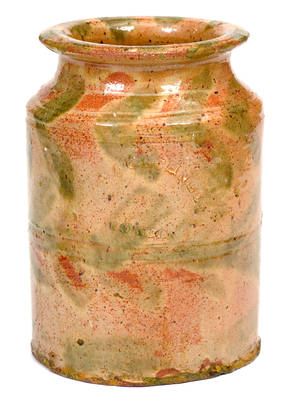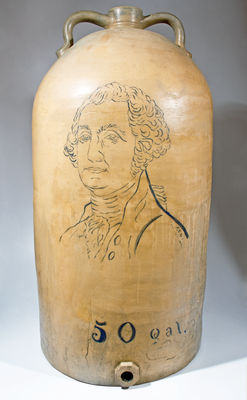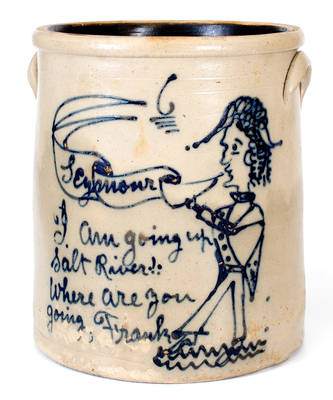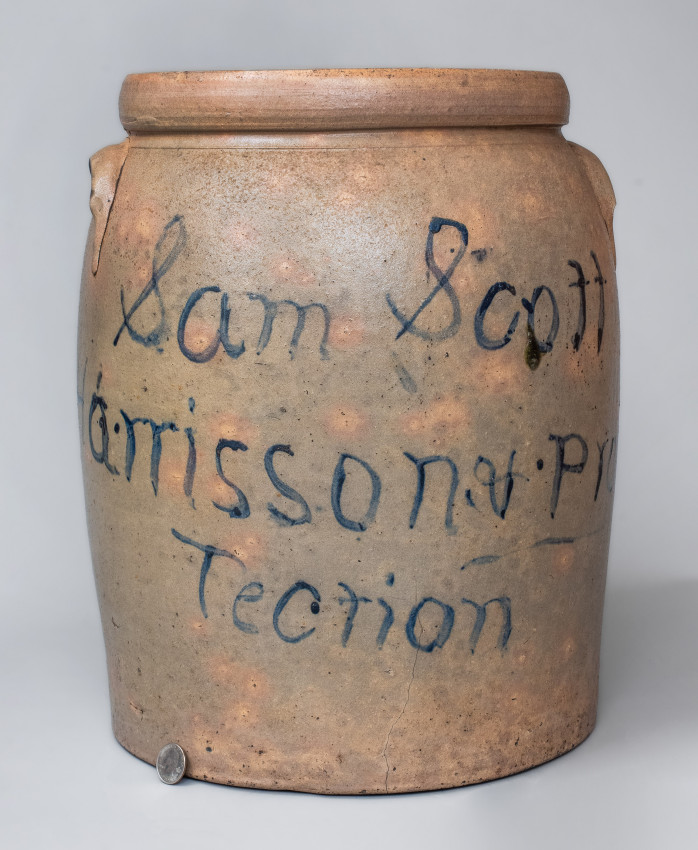Exceptional Ten-Gallon Stoneware Presentation Water Cooler with Extravagant Cobalt Cornucopia Decoration, Inscribed "H. King / Salem Ohio" and "Manufactured, / By, / G.B. Purdy, / Atwater, O," circa 1860, cylindrical, jug-form cooler with circular bunghole, two applied vertical handles at the shoulder, and semi-squared spout, lavishly-decorated with a slip-trailed design of a cornucopia brimming with a wide array of flowers and leaves. Fine detail appears throughout including cross-hatching within the design's large sunflower, spots to other blossoms, and shaded accents to the flowers and leaves, adding depth to the image. The cornucopia, festooned with banding and a scrolled terminal with foliate flourish, is given a three-dimensional quality through slip-trailed shading added to its left and right sides. The quality of the design indicates the hand of a true master of slip cup application, likely trained in the Rochester, New York tradition. The entire decoration spans an impressed 11 1/2" tall by 10 1/2" wide around the curve of the vessel's front. Additional slip-trailing appears in the form of a flower blossom surrounding the bunghole, crosshatching at the spout, stripes at the upper handle terminals, and faux screwheads at the base of the handles. The incised and cobalt highlighted inscription at the shoulder, "H. King / Salem Ohio," refers to the cooler's owner, Henry King (1833-1897), a Salem, Ohio, "farmer and iron manufacturer," according to the 1885 History of Portage County, Ohio, which states that: "In 1855 Mr. King went to Salem, Ohio, and embarked in the foundry and machine business there for fifteen years, and during that time, in connection with Pittsburgh parties, was also engaged in the manufacture of pig iron in Columbiana County, Ohio, and in Armstrong County, Penn." (pg. 608). With a background working in the railroad industry, in 1871 King was part of a group of three who patented an "improvement in railway stock-cars." The incised and cobalt-highlighted signature at the base of the cooler indicates it was made at the Atwater, Ohio, pottery of Gurdon B. Purdy (c1818-1886), a member of the prolific Purdy family of Ohio stoneware manufacturers, son of well-known Solomon Purdy (1779-1854), one of the patriarchs of northeastern Ohio stoneware. Brought up in the stoneware business, Gurdon Purdy was certainly trained by his father, who came from Vermont to Zanesville in the 1810's, then moved to Springfield (near Akron) by the 1820's. In the 1860 federal census Gurdon appears in Atwater as a potter with substantial real estate, and this would have been roughly when the cooler was made. Interestingly, Gurdon Purdy and Henry King are buried in the same cemetery, Hope Cemetery in Salem. This vessel's combination of monumental size (well over two feet tall), desirable form, over-the-top decoration, and inscriptions for both the owner and maker, place this work among the most outstanding examples of Ohio stoneware to come to auction in years. Literature: Illustrated in Treichler, A History of Northeast Ohio Stoneware, p. 92. Treichler places a photo of this jug on the same page as an image of the cover of the July 1923 issue of The Magazine Antiques, which features a jug cooler decorated by the same hand, depicting a cornucopia and figure holding crossed flags, stamped at the shoulder "G. PURDY, / ATWATER, O." Treichler writes, "It seems notable that a piece of Ohio folk art pottery was featured on the cover of this now prestigious magazine in just its second year of publication. This particular sample of Purdy's product was (and still is) owned by the Ohio Historical Society (Columbus, OH). ... [T]he magazine's staff managed to get in touch with Thomas C. Purdy of Malden, MA, a son of the pottery owner, who supplied some further information about both his family and the person who crafted the piece. ... Perhaps the most informative part of Mr. Purdy's report is found in the following quote: 'I recall the fact that my father had in his employ a German, who had worked in the German potteries as well as in some of the fine ware shops in France. The ornamental work of the jug must have been done by this man ... .' ... On the basis of the mentions of France and Germany, it is fairly likely that this piece was produced by Jacob Gelhart or one of the members of his family" (Treichler, p. 92). As Treichler also notes, "Jacob Gelhart (1822-1897), the family patriarch, was born in France, probably in the Alsatian area bordering Germany (different sons report both countries as his birthplace). Based on the ages of his three sons, he must have come to America around 1850, spent some time in New York State and arrived in Ohio by 1856. Although his occupation is not stated in the 1860 census, both he and his sons appear in subsequent decades, and they most often record their occupation as 'turner.' Jacob's tax entries begin to appear at just about the same time as the first Purdy pottery was established in Atwater, and he seems like a likely candidate to fill the role of the skillful foreign potter noted by Gurdon Purdy's son, Thomas" (Treichler, p. 91). Very nice condition. Some in-the-firing crazing to areas of cooler. An approximately 5" spider line to reverse near shoulder. A few short vertical lines to base area, the longest measuring approximately 4 3/4". A shallow 1 3/4" in-the-making base chip, which is glazed over. Three salt drips to upper body. H 28 1/2".
Special Note: Due to this object's large size, we are unable to ship it using our normal in-house shipping service. It must either be picked up by the high bidder, or special arrangements must be made by the high bidder for pick up and / or shipping by a third party. If you have any questions, please contact us; we are certainly able to recommend options for third party shippers ahead of time that you can contact for a quote.




















